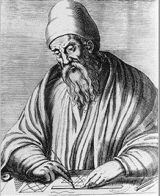

Little is known of Euclid's life. It is has even been suggested that Euclid never existed, and his works were written by a team of mathematicians. But there is strong evidence that Euclid actually existed and wrote the works attributed to him. If he did exist, he must have studied in Plato's Academy in Athens to have learnt of the geometry of Eudoxus and Theaetetus of which he was so familiar. We assume he taught at Alexandria in Egypt.
Euclid's most famous work is his treatise on mathematics The Elements. The book was a compilation of knowledge that became the centre of mathematical
teaching for 2000 years. Probably no results in it were first proved by Euclid, but the organisation of the material and its exposition are certainly his.
The Elements begins with definitions and 5 postulates. The first 3 postulates are postulates of construction, which implicitly assume the existence of points, lines and circles and the existence of other geometric objects. The fourth and fifth postulates are of a different nature. Postulate 4 states that all right angles are equal. This may seem "obvious" but it actually assumes that space in homogeneous. The famous fifth, or parallel, postulate states that one and only one line can be drawn through a point parallel to a given line. Euclid's decision to make this a postulate led to Euclidean geometry. It was not until the 19th century that this postulate was dropped and non-euclidean geometries were studied. There are also axioms which Euclid calls "common notions", such as "Things which are equal to the same thing are equal to each other".
The Elements is divided into 13 books. Books 1 to 6 deal with plane geometry. In particular, books 1 and 2 set out basic properties of triangles, parallels, parallelograms, rectangles and squares. Book 3 studies properties of the circle, while book 4 deals with problems about circles and is thought largely to set out work of the followers of Pythagoras. Book 5 lays out the work of Eudoxus on proportion applied to commensurable and incommensurable magnitudes. Book 6 looks at applications of the previous sections to plane geometry.
Books 7 to 9 deal with number theory. In particular, book 7 is a self-contained introduction to number theory and contains the Euclidean algorithm for finding the greatest common divisor of two numbers. Book 8 looks at numbers in geometrical progression.
Book 10 deals with the theory of irrational numbers and is mainly the work of Theaetetus. Euclid changed the proofs of several theorems in this book so that they fitted the new definition of proportion given by Eudoxus.
Books 11 to 13 deal with three-dimensional geometry. In book 11, the basic definitions needed for the 3 books together are given. The main results of book 12 are
that circles are to one another as the squares of their diameters and that spheres are to each other as the cubes of their diameters. These results are certainly
due to Eudoxus. Euclid proves these theorems using the "method of exhaustion" as invented by Eudoxus. Book 13 discusses the properties of the 5 regular polyhedra and gives a proof that there are precisely 5. This book appears to be based largely on an earlier treatise
by Theaetetus.
Euclid's Elements is remarkable for the clarity with which the theorems are stated and proved. The standard of rigour was to become a goal for the inventors
of the calculus centuries later.
Euclid also wrote the following books which have survived: Data, which looks at what properties of figures can be deduced when
other properties are given, On Divisions, which looks at constructions to divide a figure into two parts with areas of given ratio, Optics, which is the first
Greek work on perspective, and Phaenomena, which is an elementary introduction to mathematical astronomy and gives results on the times stars in certain
positions will rise and set.
Euclid may not have been a first class mathematician, but the long lasting nature of The Elements must make him the leading mathematics teacher of antiquity
or perhaps of all time.